Report on Managing Human Capital: Key Functions and Practices
VerifiedAdded on 2020/03/04
|18
|5718
|379
Report
AI Summary
This report provides a comprehensive overview of human capital management, exploring its evolution, definitions, and key functions. It delves into intellectual capital, workforce management, and the link between HRM practices and organizational performance, referencing relevant theories such as the Universal and Contingency perspectives, and the AMO and KSA theories. The report examines challenges in HRM, including recruitment, employee engagement, and change management. It includes a case study and discusses the role of HRM in contemporary organizations. Furthermore, it examines the importance of aligning HRM with business strategy, and provides insights into tools and systems for workforce management across various cultural contexts. The report also explores the importance of recruitment and selection systems for organizational performance.

Running head: Managing human capital 0
Managing Human Capital
Assignment
Managing Human Capital
Assignment
Paraphrase This Document
Need a fresh take? Get an instant paraphrase of this document with our AI Paraphraser
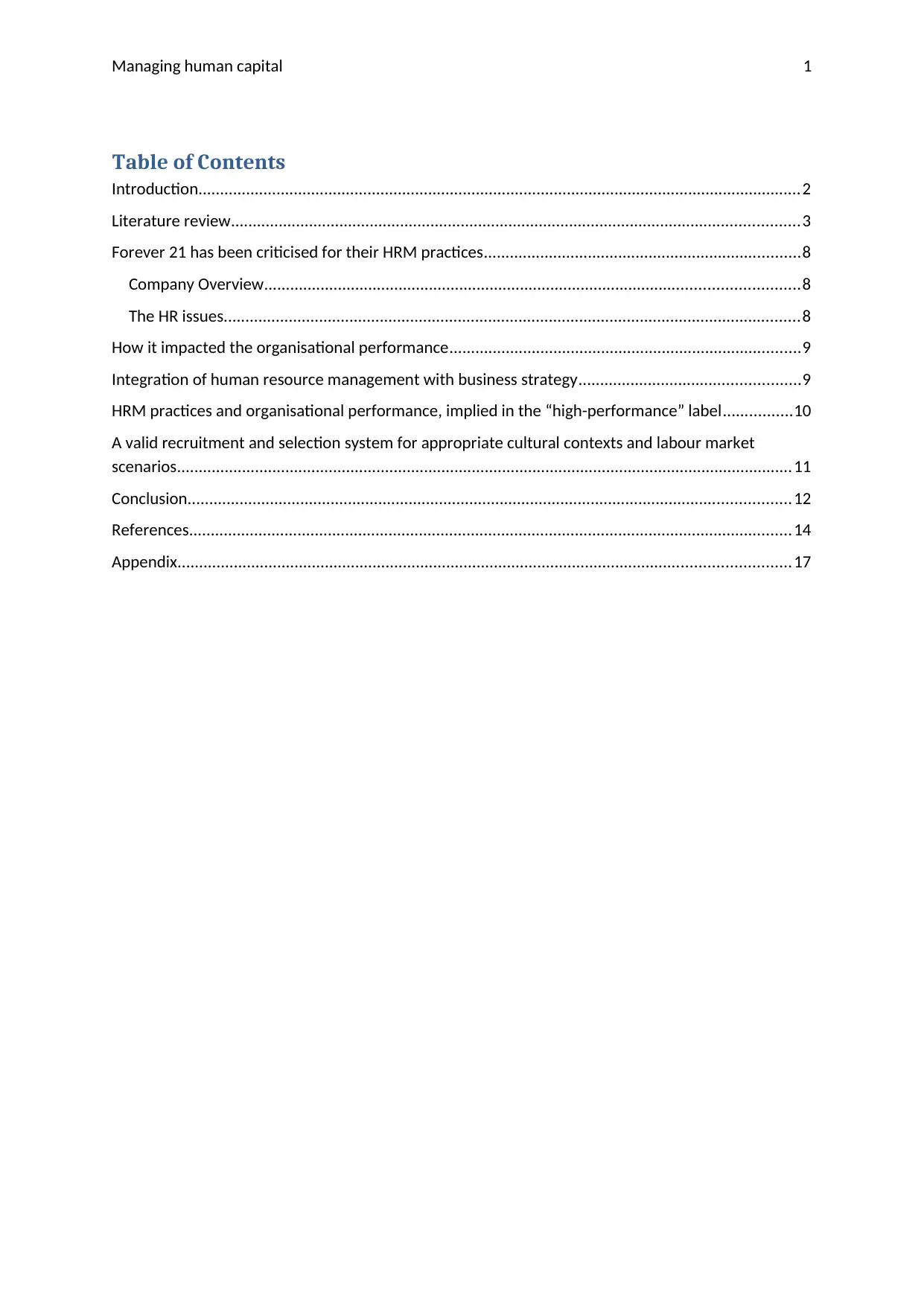
Managing human capital 1
Table of Contents
Introduction...........................................................................................................................................2
Literature review...................................................................................................................................3
Forever 21 has been criticised for their HRM practices.........................................................................8
Company Overview...........................................................................................................................8
The HR issues.....................................................................................................................................8
How it impacted the organisational performance.................................................................................9
Integration of human resource management with business strategy...................................................9
HRM practices and organisational performance, implied in the “high-performance” label................10
A valid recruitment and selection system for appropriate cultural contexts and labour market
scenarios..............................................................................................................................................11
Conclusion...........................................................................................................................................12
References...........................................................................................................................................14
Appendix.............................................................................................................................................17
Table of Contents
Introduction...........................................................................................................................................2
Literature review...................................................................................................................................3
Forever 21 has been criticised for their HRM practices.........................................................................8
Company Overview...........................................................................................................................8
The HR issues.....................................................................................................................................8
How it impacted the organisational performance.................................................................................9
Integration of human resource management with business strategy...................................................9
HRM practices and organisational performance, implied in the “high-performance” label................10
A valid recruitment and selection system for appropriate cultural contexts and labour market
scenarios..............................................................................................................................................11
Conclusion...........................................................................................................................................12
References...........................................................................................................................................14
Appendix.............................................................................................................................................17
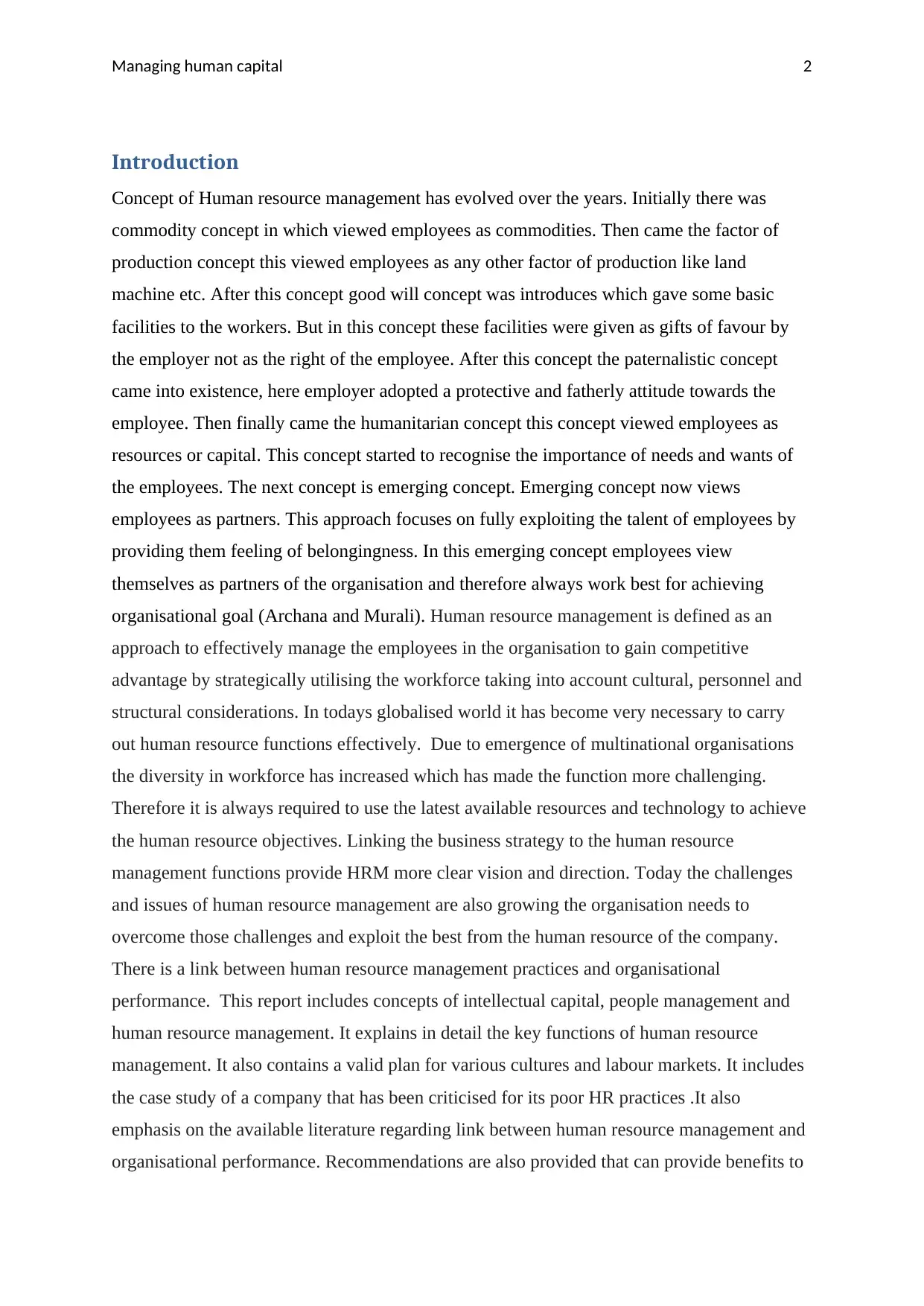
Managing human capital 2
Introduction
Concept of Human resource management has evolved over the years. Initially there was
commodity concept in which viewed employees as commodities. Then came the factor of
production concept this viewed employees as any other factor of production like land
machine etc. After this concept good will concept was introduces which gave some basic
facilities to the workers. But in this concept these facilities were given as gifts of favour by
the employer not as the right of the employee. After this concept the paternalistic concept
came into existence, here employer adopted a protective and fatherly attitude towards the
employee. Then finally came the humanitarian concept this concept viewed employees as
resources or capital. This concept started to recognise the importance of needs and wants of
the employees. The next concept is emerging concept. Emerging concept now views
employees as partners. This approach focuses on fully exploiting the talent of employees by
providing them feeling of belongingness. In this emerging concept employees view
themselves as partners of the organisation and therefore always work best for achieving
organisational goal (Archana and Murali). Human resource management is defined as an
approach to effectively manage the employees in the organisation to gain competitive
advantage by strategically utilising the workforce taking into account cultural, personnel and
structural considerations. In todays globalised world it has become very necessary to carry
out human resource functions effectively. Due to emergence of multinational organisations
the diversity in workforce has increased which has made the function more challenging.
Therefore it is always required to use the latest available resources and technology to achieve
the human resource objectives. Linking the business strategy to the human resource
management functions provide HRM more clear vision and direction. Today the challenges
and issues of human resource management are also growing the organisation needs to
overcome those challenges and exploit the best from the human resource of the company.
There is a link between human resource management practices and organisational
performance. This report includes concepts of intellectual capital, people management and
human resource management. It explains in detail the key functions of human resource
management. It also contains a valid plan for various cultures and labour markets. It includes
the case study of a company that has been criticised for its poor HR practices .It also
emphasis on the available literature regarding link between human resource management and
organisational performance. Recommendations are also provided that can provide benefits to
Introduction
Concept of Human resource management has evolved over the years. Initially there was
commodity concept in which viewed employees as commodities. Then came the factor of
production concept this viewed employees as any other factor of production like land
machine etc. After this concept good will concept was introduces which gave some basic
facilities to the workers. But in this concept these facilities were given as gifts of favour by
the employer not as the right of the employee. After this concept the paternalistic concept
came into existence, here employer adopted a protective and fatherly attitude towards the
employee. Then finally came the humanitarian concept this concept viewed employees as
resources or capital. This concept started to recognise the importance of needs and wants of
the employees. The next concept is emerging concept. Emerging concept now views
employees as partners. This approach focuses on fully exploiting the talent of employees by
providing them feeling of belongingness. In this emerging concept employees view
themselves as partners of the organisation and therefore always work best for achieving
organisational goal (Archana and Murali). Human resource management is defined as an
approach to effectively manage the employees in the organisation to gain competitive
advantage by strategically utilising the workforce taking into account cultural, personnel and
structural considerations. In todays globalised world it has become very necessary to carry
out human resource functions effectively. Due to emergence of multinational organisations
the diversity in workforce has increased which has made the function more challenging.
Therefore it is always required to use the latest available resources and technology to achieve
the human resource objectives. Linking the business strategy to the human resource
management functions provide HRM more clear vision and direction. Today the challenges
and issues of human resource management are also growing the organisation needs to
overcome those challenges and exploit the best from the human resource of the company.
There is a link between human resource management practices and organisational
performance. This report includes concepts of intellectual capital, people management and
human resource management. It explains in detail the key functions of human resource
management. It also contains a valid plan for various cultures and labour markets. It includes
the case study of a company that has been criticised for its poor HR practices .It also
emphasis on the available literature regarding link between human resource management and
organisational performance. Recommendations are also provided that can provide benefits to
⊘ This is a preview!⊘
Do you want full access?
Subscribe today to unlock all pages.

Trusted by 1+ million students worldwide
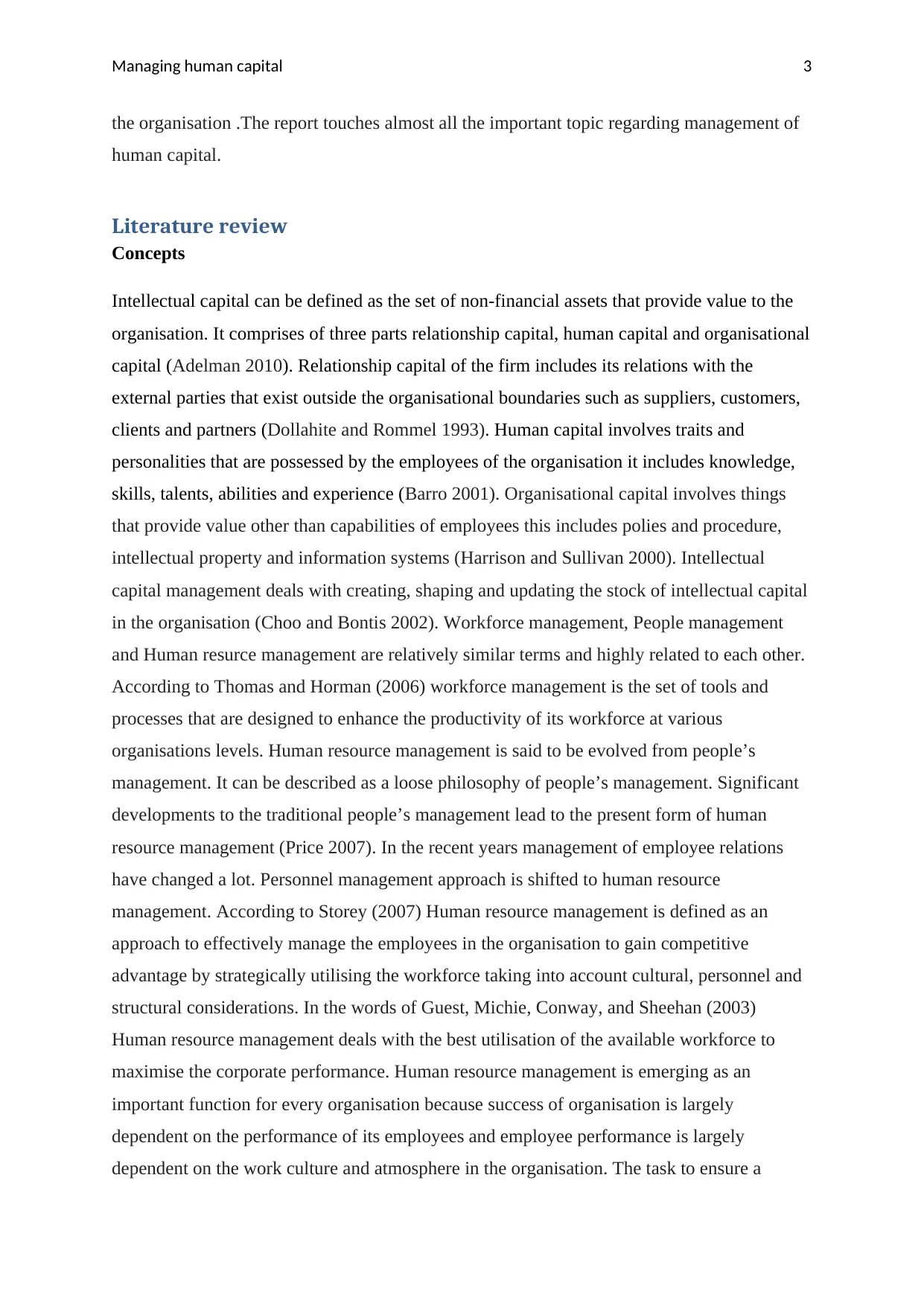
Managing human capital 3
the organisation .The report touches almost all the important topic regarding management of
human capital.
Literature review
Concepts
Intellectual capital can be defined as the set of non-financial assets that provide value to the
organisation. It comprises of three parts relationship capital, human capital and organisational
capital (Adelman 2010). Relationship capital of the firm includes its relations with the
external parties that exist outside the organisational boundaries such as suppliers, customers,
clients and partners (Dollahite and Rommel 1993). Human capital involves traits and
personalities that are possessed by the employees of the organisation it includes knowledge,
skills, talents, abilities and experience (Barro 2001). Organisational capital involves things
that provide value other than capabilities of employees this includes polies and procedure,
intellectual property and information systems (Harrison and Sullivan 2000). Intellectual
capital management deals with creating, shaping and updating the stock of intellectual capital
in the organisation (Choo and Bontis 2002). Workforce management, People management
and Human resurce management are relatively similar terms and highly related to each other.
According to Thomas and Horman (2006) workforce management is the set of tools and
processes that are designed to enhance the productivity of its workforce at various
organisations levels. Human resource management is said to be evolved from people’s
management. It can be described as a loose philosophy of people’s management. Significant
developments to the traditional people’s management lead to the present form of human
resource management (Price 2007). In the recent years management of employee relations
have changed a lot. Personnel management approach is shifted to human resource
management. According to Storey (2007) Human resource management is defined as an
approach to effectively manage the employees in the organisation to gain competitive
advantage by strategically utilising the workforce taking into account cultural, personnel and
structural considerations. In the words of Guest, Michie, Conway, and Sheehan (2003)
Human resource management deals with the best utilisation of the available workforce to
maximise the corporate performance. Human resource management is emerging as an
important function for every organisation because success of organisation is largely
dependent on the performance of its employees and employee performance is largely
dependent on the work culture and atmosphere in the organisation. The task to ensure a
the organisation .The report touches almost all the important topic regarding management of
human capital.
Literature review
Concepts
Intellectual capital can be defined as the set of non-financial assets that provide value to the
organisation. It comprises of three parts relationship capital, human capital and organisational
capital (Adelman 2010). Relationship capital of the firm includes its relations with the
external parties that exist outside the organisational boundaries such as suppliers, customers,
clients and partners (Dollahite and Rommel 1993). Human capital involves traits and
personalities that are possessed by the employees of the organisation it includes knowledge,
skills, talents, abilities and experience (Barro 2001). Organisational capital involves things
that provide value other than capabilities of employees this includes polies and procedure,
intellectual property and information systems (Harrison and Sullivan 2000). Intellectual
capital management deals with creating, shaping and updating the stock of intellectual capital
in the organisation (Choo and Bontis 2002). Workforce management, People management
and Human resurce management are relatively similar terms and highly related to each other.
According to Thomas and Horman (2006) workforce management is the set of tools and
processes that are designed to enhance the productivity of its workforce at various
organisations levels. Human resource management is said to be evolved from people’s
management. It can be described as a loose philosophy of people’s management. Significant
developments to the traditional people’s management lead to the present form of human
resource management (Price 2007). In the recent years management of employee relations
have changed a lot. Personnel management approach is shifted to human resource
management. According to Storey (2007) Human resource management is defined as an
approach to effectively manage the employees in the organisation to gain competitive
advantage by strategically utilising the workforce taking into account cultural, personnel and
structural considerations. In the words of Guest, Michie, Conway, and Sheehan (2003)
Human resource management deals with the best utilisation of the available workforce to
maximise the corporate performance. Human resource management is emerging as an
important function for every organisation because success of organisation is largely
dependent on the performance of its employees and employee performance is largely
dependent on the work culture and atmosphere in the organisation. The task to ensure a
Paraphrase This Document
Need a fresh take? Get an instant paraphrase of this document with our AI Paraphraser

Managing human capital 4
positive balance between organisation culture and employee performance is done by human
resource department (Armstrong and Taylor2014). The concept of HRM can be better
understood with the help of characteristics. The basic characteristics of human resource
management are it is commitment oriented in nature, it is diverse & strategic, focus on
business value and it is a management driven activity (Kim 2017).
Human Resource Management in detail
An effective Human resource plan involves 6 basic steps, the extent and nature of these steps
keeps changing according to different situations. The steps include determining human
resource needs, determine recruiting strategy, select employees, develop training, determine
compensation and appraise the performance (Noe, Hollenbeck, Gerhart, and Wright, 2003).
The basic objectives of human resource management are achieving organisational goals,
managing human capital; maintain employee relations, rewards and compensation
management and knowledge management (Rees and Smith 2017). These objectives can be
achieved only by performing the human resource functions well. HRM has various functions.
Deb (2006) defines five basic categories of HRM functions which involve managerial,
operational, developmental, analytical and strategic functions. Managerial functions involve
basic management of planning, organising, directing and controlling. Operational functions
involve human resource planning, human resource acquisition, compensation and benefits,
occupational safety and health, integrations and maintenance and employee relationships. The
main features of employee acquisition include recruitment and selection. Recruitment can be
defined as process of attracting the pool of talent to the organisation (Breaugh, and Starke
2000). Selection in human resource management means evaluating the available alternatives
and choosing the best suited person for the job (Minbaeva 2005). Designing an appropriate
recruitment and selection system is very essential for an organisation as recruitment and
selection has positive relationship with the organisational performance. The developmental
functions include HR policy, career & succession development, training and development,
performance management and total quality management. Analytical functions involve HR
consultation, HR research and HR reform. Strategic functions include HR strategy, HR
outsourcing, HR mergers and acquisitions.
Issues and challenges in HRM
positive balance between organisation culture and employee performance is done by human
resource department (Armstrong and Taylor2014). The concept of HRM can be better
understood with the help of characteristics. The basic characteristics of human resource
management are it is commitment oriented in nature, it is diverse & strategic, focus on
business value and it is a management driven activity (Kim 2017).
Human Resource Management in detail
An effective Human resource plan involves 6 basic steps, the extent and nature of these steps
keeps changing according to different situations. The steps include determining human
resource needs, determine recruiting strategy, select employees, develop training, determine
compensation and appraise the performance (Noe, Hollenbeck, Gerhart, and Wright, 2003).
The basic objectives of human resource management are achieving organisational goals,
managing human capital; maintain employee relations, rewards and compensation
management and knowledge management (Rees and Smith 2017). These objectives can be
achieved only by performing the human resource functions well. HRM has various functions.
Deb (2006) defines five basic categories of HRM functions which involve managerial,
operational, developmental, analytical and strategic functions. Managerial functions involve
basic management of planning, organising, directing and controlling. Operational functions
involve human resource planning, human resource acquisition, compensation and benefits,
occupational safety and health, integrations and maintenance and employee relationships. The
main features of employee acquisition include recruitment and selection. Recruitment can be
defined as process of attracting the pool of talent to the organisation (Breaugh, and Starke
2000). Selection in human resource management means evaluating the available alternatives
and choosing the best suited person for the job (Minbaeva 2005). Designing an appropriate
recruitment and selection system is very essential for an organisation as recruitment and
selection has positive relationship with the organisational performance. The developmental
functions include HR policy, career & succession development, training and development,
performance management and total quality management. Analytical functions involve HR
consultation, HR research and HR reform. Strategic functions include HR strategy, HR
outsourcing, HR mergers and acquisitions.
Issues and challenges in HRM
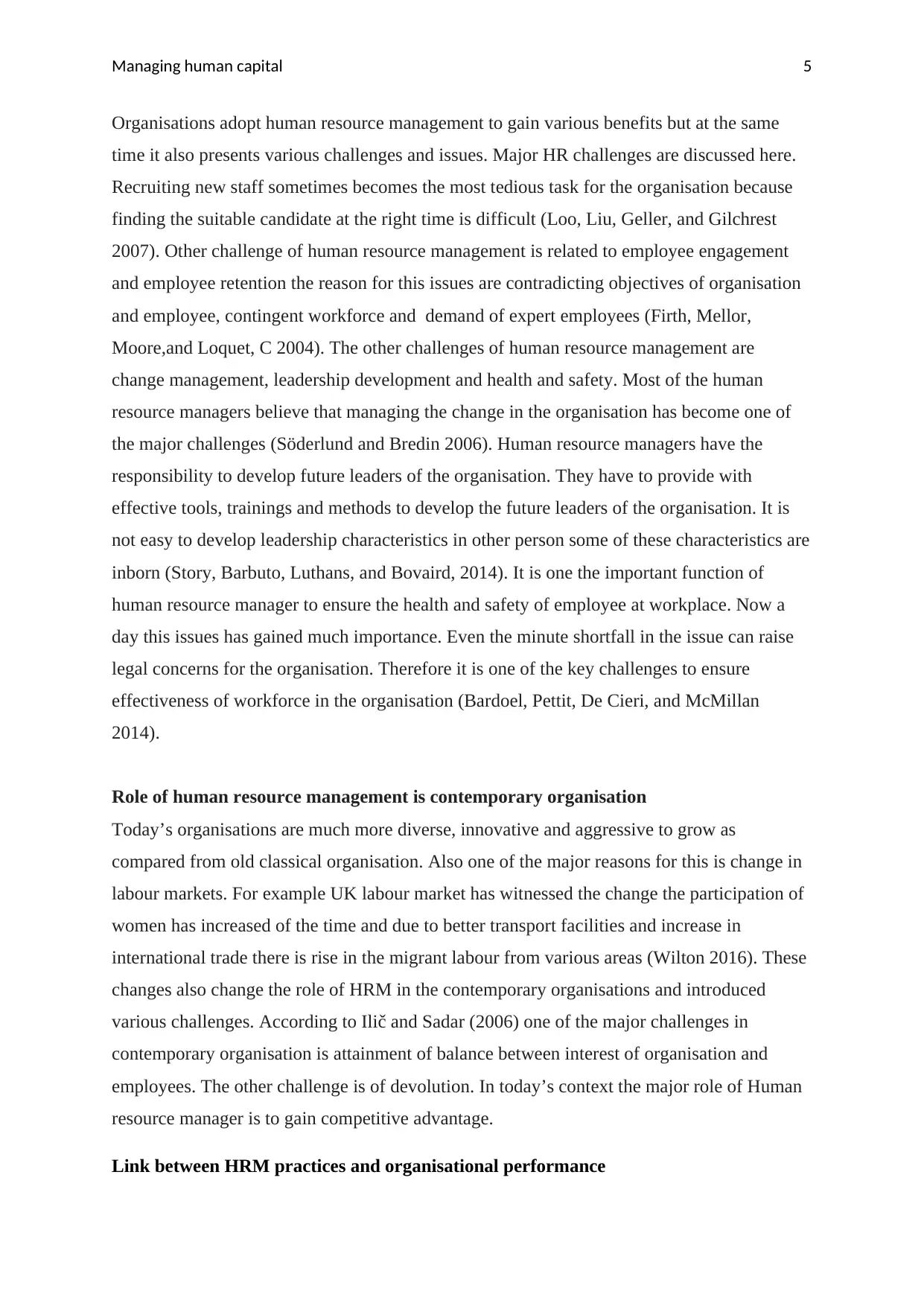
Managing human capital 5
Organisations adopt human resource management to gain various benefits but at the same
time it also presents various challenges and issues. Major HR challenges are discussed here.
Recruiting new staff sometimes becomes the most tedious task for the organisation because
finding the suitable candidate at the right time is difficult (Loo, Liu, Geller, and Gilchrest
2007). Other challenge of human resource management is related to employee engagement
and employee retention the reason for this issues are contradicting objectives of organisation
and employee, contingent workforce and demand of expert employees (Firth, Mellor,
Moore,and Loquet, C 2004). The other challenges of human resource management are
change management, leadership development and health and safety. Most of the human
resource managers believe that managing the change in the organisation has become one of
the major challenges (Söderlund and Bredin 2006). Human resource managers have the
responsibility to develop future leaders of the organisation. They have to provide with
effective tools, trainings and methods to develop the future leaders of the organisation. It is
not easy to develop leadership characteristics in other person some of these characteristics are
inborn (Story, Barbuto, Luthans, and Bovaird, 2014). It is one the important function of
human resource manager to ensure the health and safety of employee at workplace. Now a
day this issues has gained much importance. Even the minute shortfall in the issue can raise
legal concerns for the organisation. Therefore it is one of the key challenges to ensure
effectiveness of workforce in the organisation (Bardoel, Pettit, De Cieri, and McMillan
2014).
Role of human resource management is contemporary organisation
Today’s organisations are much more diverse, innovative and aggressive to grow as
compared from old classical organisation. Also one of the major reasons for this is change in
labour markets. For example UK labour market has witnessed the change the participation of
women has increased of the time and due to better transport facilities and increase in
international trade there is rise in the migrant labour from various areas (Wilton 2016). These
changes also change the role of HRM in the contemporary organisations and introduced
various challenges. According to Ilič and Sadar (2006) one of the major challenges in
contemporary organisation is attainment of balance between interest of organisation and
employees. The other challenge is of devolution. In today’s context the major role of Human
resource manager is to gain competitive advantage.
Link between HRM practices and organisational performance
Organisations adopt human resource management to gain various benefits but at the same
time it also presents various challenges and issues. Major HR challenges are discussed here.
Recruiting new staff sometimes becomes the most tedious task for the organisation because
finding the suitable candidate at the right time is difficult (Loo, Liu, Geller, and Gilchrest
2007). Other challenge of human resource management is related to employee engagement
and employee retention the reason for this issues are contradicting objectives of organisation
and employee, contingent workforce and demand of expert employees (Firth, Mellor,
Moore,and Loquet, C 2004). The other challenges of human resource management are
change management, leadership development and health and safety. Most of the human
resource managers believe that managing the change in the organisation has become one of
the major challenges (Söderlund and Bredin 2006). Human resource managers have the
responsibility to develop future leaders of the organisation. They have to provide with
effective tools, trainings and methods to develop the future leaders of the organisation. It is
not easy to develop leadership characteristics in other person some of these characteristics are
inborn (Story, Barbuto, Luthans, and Bovaird, 2014). It is one the important function of
human resource manager to ensure the health and safety of employee at workplace. Now a
day this issues has gained much importance. Even the minute shortfall in the issue can raise
legal concerns for the organisation. Therefore it is one of the key challenges to ensure
effectiveness of workforce in the organisation (Bardoel, Pettit, De Cieri, and McMillan
2014).
Role of human resource management is contemporary organisation
Today’s organisations are much more diverse, innovative and aggressive to grow as
compared from old classical organisation. Also one of the major reasons for this is change in
labour markets. For example UK labour market has witnessed the change the participation of
women has increased of the time and due to better transport facilities and increase in
international trade there is rise in the migrant labour from various areas (Wilton 2016). These
changes also change the role of HRM in the contemporary organisations and introduced
various challenges. According to Ilič and Sadar (2006) one of the major challenges in
contemporary organisation is attainment of balance between interest of organisation and
employees. The other challenge is of devolution. In today’s context the major role of Human
resource manager is to gain competitive advantage.
Link between HRM practices and organisational performance
⊘ This is a preview!⊘
Do you want full access?
Subscribe today to unlock all pages.

Trusted by 1+ million students worldwide
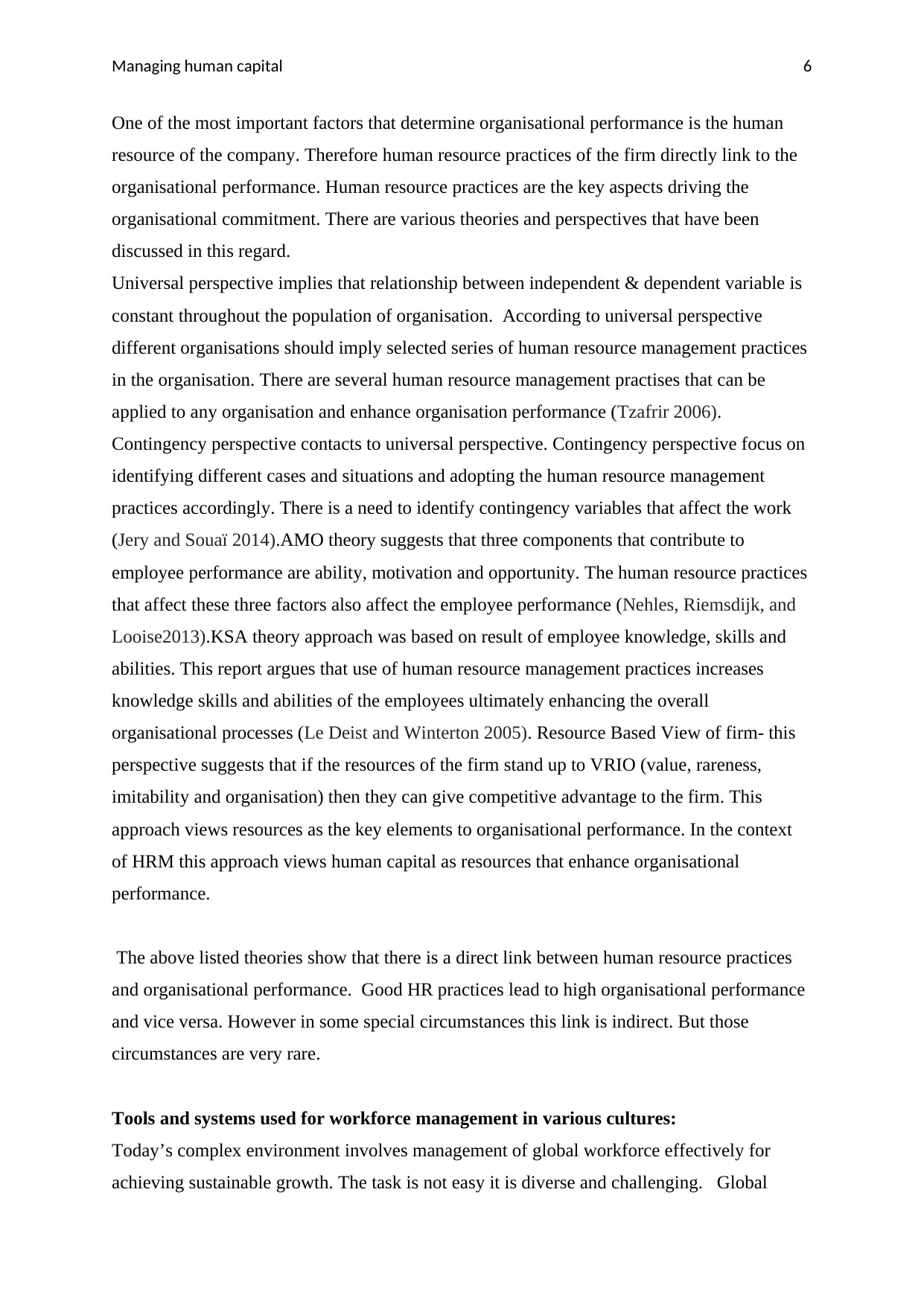
Managing human capital 6
One of the most important factors that determine organisational performance is the human
resource of the company. Therefore human resource practices of the firm directly link to the
organisational performance. Human resource practices are the key aspects driving the
organisational commitment. There are various theories and perspectives that have been
discussed in this regard.
Universal perspective implies that relationship between independent & dependent variable is
constant throughout the population of organisation. According to universal perspective
different organisations should imply selected series of human resource management practices
in the organisation. There are several human resource management practises that can be
applied to any organisation and enhance organisation performance (Tzafrir 2006).
Contingency perspective contacts to universal perspective. Contingency perspective focus on
identifying different cases and situations and adopting the human resource management
practices accordingly. There is a need to identify contingency variables that affect the work
(Jery and Souaï 2014).AMO theory suggests that three components that contribute to
employee performance are ability, motivation and opportunity. The human resource practices
that affect these three factors also affect the employee performance (Nehles, Riemsdijk, and
Looise2013).KSA theory approach was based on result of employee knowledge, skills and
abilities. This report argues that use of human resource management practices increases
knowledge skills and abilities of the employees ultimately enhancing the overall
organisational processes (Le Deist and Winterton 2005). Resource Based View of firm- this
perspective suggests that if the resources of the firm stand up to VRIO (value, rareness,
imitability and organisation) then they can give competitive advantage to the firm. This
approach views resources as the key elements to organisational performance. In the context
of HRM this approach views human capital as resources that enhance organisational
performance.
The above listed theories show that there is a direct link between human resource practices
and organisational performance. Good HR practices lead to high organisational performance
and vice versa. However in some special circumstances this link is indirect. But those
circumstances are very rare.
Tools and systems used for workforce management in various cultures:
Today’s complex environment involves management of global workforce effectively for
achieving sustainable growth. The task is not easy it is diverse and challenging. Global
One of the most important factors that determine organisational performance is the human
resource of the company. Therefore human resource practices of the firm directly link to the
organisational performance. Human resource practices are the key aspects driving the
organisational commitment. There are various theories and perspectives that have been
discussed in this regard.
Universal perspective implies that relationship between independent & dependent variable is
constant throughout the population of organisation. According to universal perspective
different organisations should imply selected series of human resource management practices
in the organisation. There are several human resource management practises that can be
applied to any organisation and enhance organisation performance (Tzafrir 2006).
Contingency perspective contacts to universal perspective. Contingency perspective focus on
identifying different cases and situations and adopting the human resource management
practices accordingly. There is a need to identify contingency variables that affect the work
(Jery and Souaï 2014).AMO theory suggests that three components that contribute to
employee performance are ability, motivation and opportunity. The human resource practices
that affect these three factors also affect the employee performance (Nehles, Riemsdijk, and
Looise2013).KSA theory approach was based on result of employee knowledge, skills and
abilities. This report argues that use of human resource management practices increases
knowledge skills and abilities of the employees ultimately enhancing the overall
organisational processes (Le Deist and Winterton 2005). Resource Based View of firm- this
perspective suggests that if the resources of the firm stand up to VRIO (value, rareness,
imitability and organisation) then they can give competitive advantage to the firm. This
approach views resources as the key elements to organisational performance. In the context
of HRM this approach views human capital as resources that enhance organisational
performance.
The above listed theories show that there is a direct link between human resource practices
and organisational performance. Good HR practices lead to high organisational performance
and vice versa. However in some special circumstances this link is indirect. But those
circumstances are very rare.
Tools and systems used for workforce management in various cultures:
Today’s complex environment involves management of global workforce effectively for
achieving sustainable growth. The task is not easy it is diverse and challenging. Global
Paraphrase This Document
Need a fresh take? Get an instant paraphrase of this document with our AI Paraphraser

Managing human capital 7
talent management is challenging in nature because of the geographical and cultural
boundaries (Tarique and Schuler).
There are various tools and systems that are used in the context of management of labour
force. These systems and tools help the organisation to do the work with much ease and
efficiency.
Demand management -Today’s workforce management involves demand management
process to forecast work orders and to plan the required number of workforce.
Implementation of demand management process in the organisation ensures optimum
utilisation of existing employees, avoiding bottle necks and reducing over staffing (Losey,
Mesinger, and Ulrich). Workforce scheduling- Workforce scheduling is an effective
technique used by the organisations world-wide. This is a technique which enables a manger
to make a schedule that gets job done. In this technique manger forecasts the needs that
require to be fulfilled and expected time required to meet the need. It is an effective technique
but often criticised because it has the chances for unavoidable mistakes and time consuming.
It can also be frustrating to some mangers (O'brien 2003).Workforce dispatcher- Workforce
dispatcher is used by various organisations. There are different kinds to soft wares for this
task. It automatically allocates the task to the suitable employees on the basis of some pre-
defined criteria. This method saves lot of time and very efficient. The only disadvantage
related to this is, sometimes wrong allocations are made. But to this issue the solutions are
available the mobile solutions make employees and dispatchers to communicate in real time
(Shah, et al. 2013). Softwares- There is varieties of software available in the market that helps
the companies in workforce management. One such software is PeopleSoft Inc. This allows
the organisations to maintain the rankings of its employees and also includes various
comments by their supervisors, their location and availability. This software has also
designed a Business Analyzer Modeler this helps identify the best suitable employees for a
desired project. This software is widely used by UK companies. But the drawback with using
this software’s is the cost and some of the HR software’s are reported to be complex in use
(Sinclair, 2004).
talent management is challenging in nature because of the geographical and cultural
boundaries (Tarique and Schuler).
There are various tools and systems that are used in the context of management of labour
force. These systems and tools help the organisation to do the work with much ease and
efficiency.
Demand management -Today’s workforce management involves demand management
process to forecast work orders and to plan the required number of workforce.
Implementation of demand management process in the organisation ensures optimum
utilisation of existing employees, avoiding bottle necks and reducing over staffing (Losey,
Mesinger, and Ulrich). Workforce scheduling- Workforce scheduling is an effective
technique used by the organisations world-wide. This is a technique which enables a manger
to make a schedule that gets job done. In this technique manger forecasts the needs that
require to be fulfilled and expected time required to meet the need. It is an effective technique
but often criticised because it has the chances for unavoidable mistakes and time consuming.
It can also be frustrating to some mangers (O'brien 2003).Workforce dispatcher- Workforce
dispatcher is used by various organisations. There are different kinds to soft wares for this
task. It automatically allocates the task to the suitable employees on the basis of some pre-
defined criteria. This method saves lot of time and very efficient. The only disadvantage
related to this is, sometimes wrong allocations are made. But to this issue the solutions are
available the mobile solutions make employees and dispatchers to communicate in real time
(Shah, et al. 2013). Softwares- There is varieties of software available in the market that helps
the companies in workforce management. One such software is PeopleSoft Inc. This allows
the organisations to maintain the rankings of its employees and also includes various
comments by their supervisors, their location and availability. This software has also
designed a Business Analyzer Modeler this helps identify the best suitable employees for a
desired project. This software is widely used by UK companies. But the drawback with using
this software’s is the cost and some of the HR software’s are reported to be complex in use
(Sinclair, 2004).
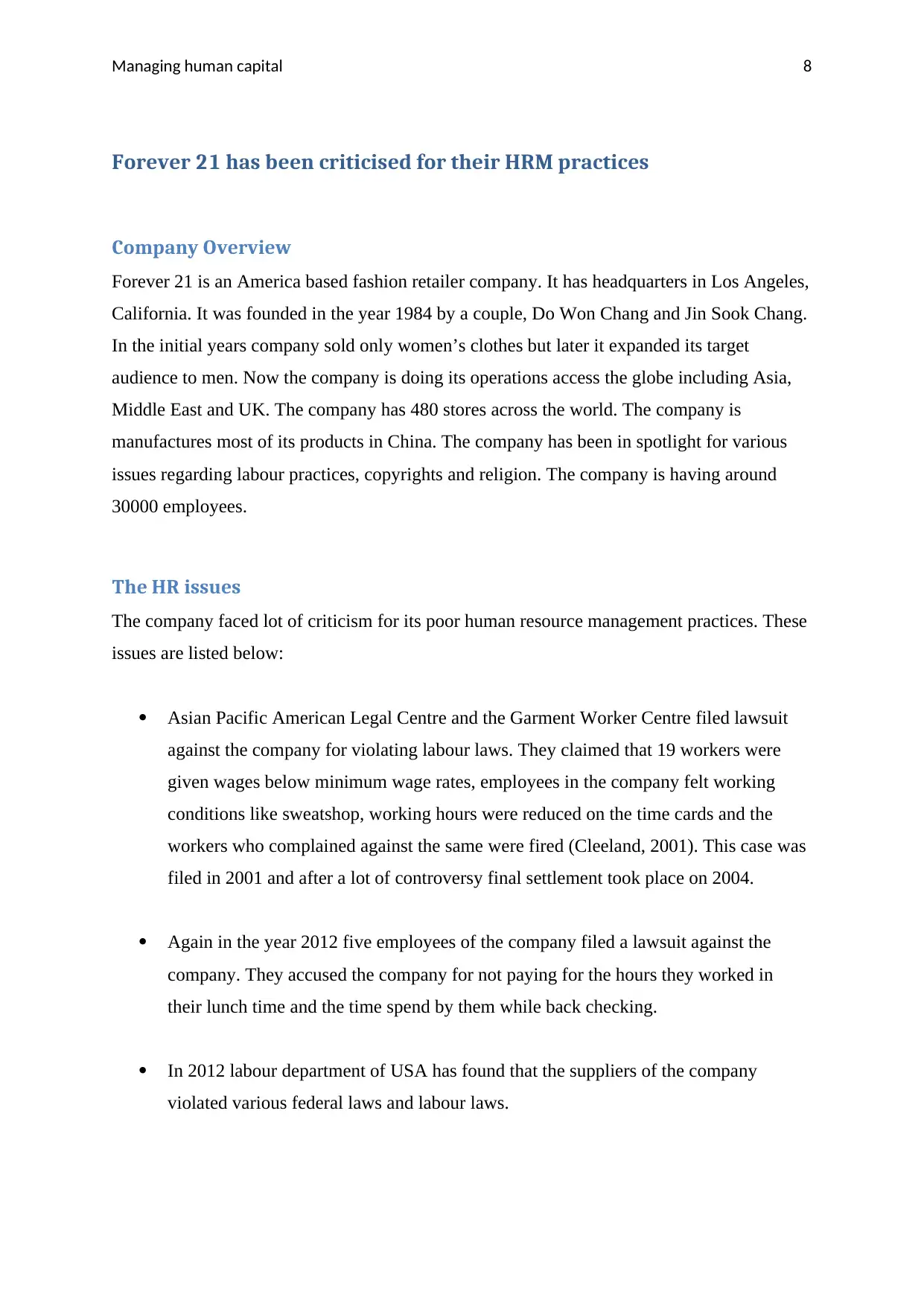
Managing human capital 8
Forever 21 has been criticised for their HRM practices
Company Overview
Forever 21 is an America based fashion retailer company. It has headquarters in Los Angeles,
California. It was founded in the year 1984 by a couple, Do Won Chang and Jin Sook Chang.
In the initial years company sold only women’s clothes but later it expanded its target
audience to men. Now the company is doing its operations access the globe including Asia,
Middle East and UK. The company has 480 stores across the world. The company is
manufactures most of its products in China. The company has been in spotlight for various
issues regarding labour practices, copyrights and religion. The company is having around
30000 employees.
The HR issues
The company faced lot of criticism for its poor human resource management practices. These
issues are listed below:
Asian Pacific American Legal Centre and the Garment Worker Centre filed lawsuit
against the company for violating labour laws. They claimed that 19 workers were
given wages below minimum wage rates, employees in the company felt working
conditions like sweatshop, working hours were reduced on the time cards and the
workers who complained against the same were fired (Cleeland, 2001). This case was
filed in 2001 and after a lot of controversy final settlement took place on 2004.
Again in the year 2012 five employees of the company filed a lawsuit against the
company. They accused the company for not paying for the hours they worked in
their lunch time and the time spend by them while back checking.
In 2012 labour department of USA has found that the suppliers of the company
violated various federal laws and labour laws.
Forever 21 has been criticised for their HRM practices
Company Overview
Forever 21 is an America based fashion retailer company. It has headquarters in Los Angeles,
California. It was founded in the year 1984 by a couple, Do Won Chang and Jin Sook Chang.
In the initial years company sold only women’s clothes but later it expanded its target
audience to men. Now the company is doing its operations access the globe including Asia,
Middle East and UK. The company has 480 stores across the world. The company is
manufactures most of its products in China. The company has been in spotlight for various
issues regarding labour practices, copyrights and religion. The company is having around
30000 employees.
The HR issues
The company faced lot of criticism for its poor human resource management practices. These
issues are listed below:
Asian Pacific American Legal Centre and the Garment Worker Centre filed lawsuit
against the company for violating labour laws. They claimed that 19 workers were
given wages below minimum wage rates, employees in the company felt working
conditions like sweatshop, working hours were reduced on the time cards and the
workers who complained against the same were fired (Cleeland, 2001). This case was
filed in 2001 and after a lot of controversy final settlement took place on 2004.
Again in the year 2012 five employees of the company filed a lawsuit against the
company. They accused the company for not paying for the hours they worked in
their lunch time and the time spend by them while back checking.
In 2012 labour department of USA has found that the suppliers of the company
violated various federal laws and labour laws.
⊘ This is a preview!⊘
Do you want full access?
Subscribe today to unlock all pages.

Trusted by 1+ million students worldwide

Managing human capital 9
Recently in the year 2017 another lawsuit was filed against company by Department
of Fair Employment and Housing for discriminating against Spanish speaking
employees. The department accused that the company’s English only policy stopped
the workers to speak any other language during work hours and during the employee
rest hours (Fashion Law, 2016).
How it impacted the organisational performance
These issues impacted organisational image to a large extent. The company is in a tough
position because of these issues. The company has to incur various financial loses and also
lost its brand images. Sales and profits of the company almost die out after these issues. After
the lawsuit that was filed in 2001 US garment workers boycotted the company for 3 years this
impacted the sales of company to large extent. The documentary named Made in LA was
made that highlighted the struggle of the workers (Schlossberg, 2015). This added more to
the plight of the company. The company’s image due to poor human resource practises
degraded to a large extent. The company was not able to attract and hire talented employees.
The poor quality workforce impacted the organisational performance to the great extent.
Company’s poor HR practices also imposed various kinds of fines on the company by various
courts. The funds that could be used for producing higher levels were used on paying fines.
Poor human resource management adversely impacted the organisational performance of the
company.
Integration of human resource management with business strategy
The more strategic approach towards HRM can help the company to enhance its
organisational performance. Recommendations for Forever New for developing strategic
approach of human resource management for the benefits of the company:
The company should integrate corporate values with the HRM strategic plan. The
Human resource management should highlight and reflect vision and mission of the
Recently in the year 2017 another lawsuit was filed against company by Department
of Fair Employment and Housing for discriminating against Spanish speaking
employees. The department accused that the company’s English only policy stopped
the workers to speak any other language during work hours and during the employee
rest hours (Fashion Law, 2016).
How it impacted the organisational performance
These issues impacted organisational image to a large extent. The company is in a tough
position because of these issues. The company has to incur various financial loses and also
lost its brand images. Sales and profits of the company almost die out after these issues. After
the lawsuit that was filed in 2001 US garment workers boycotted the company for 3 years this
impacted the sales of company to large extent. The documentary named Made in LA was
made that highlighted the struggle of the workers (Schlossberg, 2015). This added more to
the plight of the company. The company’s image due to poor human resource practises
degraded to a large extent. The company was not able to attract and hire talented employees.
The poor quality workforce impacted the organisational performance to the great extent.
Company’s poor HR practices also imposed various kinds of fines on the company by various
courts. The funds that could be used for producing higher levels were used on paying fines.
Poor human resource management adversely impacted the organisational performance of the
company.
Integration of human resource management with business strategy
The more strategic approach towards HRM can help the company to enhance its
organisational performance. Recommendations for Forever New for developing strategic
approach of human resource management for the benefits of the company:
The company should integrate corporate values with the HRM strategic plan. The
Human resource management should highlight and reflect vision and mission of the
Paraphrase This Document
Need a fresh take? Get an instant paraphrase of this document with our AI Paraphraser
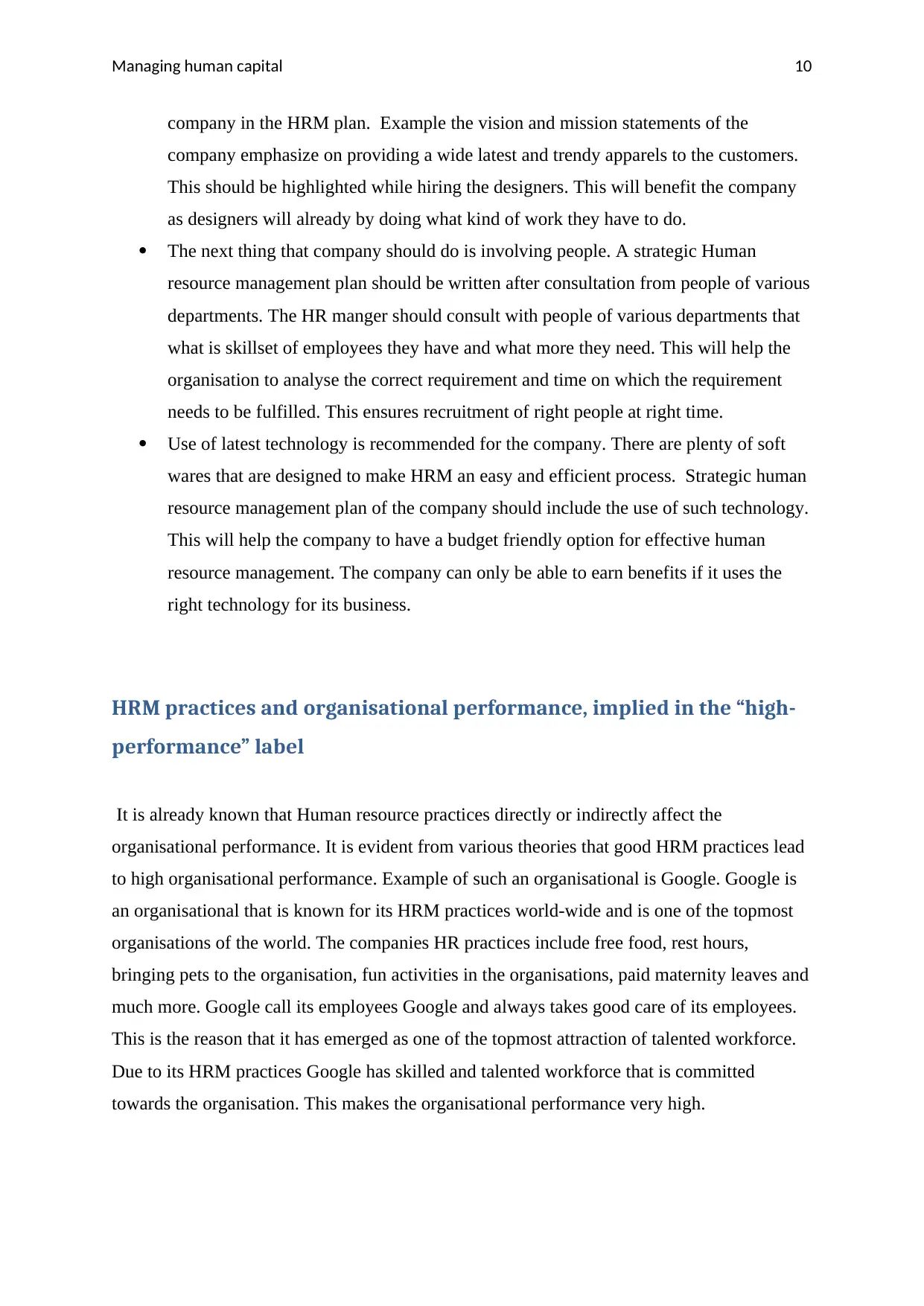
Managing human capital 10
company in the HRM plan. Example the vision and mission statements of the
company emphasize on providing a wide latest and trendy apparels to the customers.
This should be highlighted while hiring the designers. This will benefit the company
as designers will already by doing what kind of work they have to do.
The next thing that company should do is involving people. A strategic Human
resource management plan should be written after consultation from people of various
departments. The HR manger should consult with people of various departments that
what is skillset of employees they have and what more they need. This will help the
organisation to analyse the correct requirement and time on which the requirement
needs to be fulfilled. This ensures recruitment of right people at right time.
Use of latest technology is recommended for the company. There are plenty of soft
wares that are designed to make HRM an easy and efficient process. Strategic human
resource management plan of the company should include the use of such technology.
This will help the company to have a budget friendly option for effective human
resource management. The company can only be able to earn benefits if it uses the
right technology for its business.
HRM practices and organisational performance, implied in the “high-
performance” label
It is already known that Human resource practices directly or indirectly affect the
organisational performance. It is evident from various theories that good HRM practices lead
to high organisational performance. Example of such an organisational is Google. Google is
an organisational that is known for its HRM practices world-wide and is one of the topmost
organisations of the world. The companies HR practices include free food, rest hours,
bringing pets to the organisation, fun activities in the organisations, paid maternity leaves and
much more. Google call its employees Google and always takes good care of its employees.
This is the reason that it has emerged as one of the topmost attraction of talented workforce.
Due to its HRM practices Google has skilled and talented workforce that is committed
towards the organisation. This makes the organisational performance very high.
company in the HRM plan. Example the vision and mission statements of the
company emphasize on providing a wide latest and trendy apparels to the customers.
This should be highlighted while hiring the designers. This will benefit the company
as designers will already by doing what kind of work they have to do.
The next thing that company should do is involving people. A strategic Human
resource management plan should be written after consultation from people of various
departments. The HR manger should consult with people of various departments that
what is skillset of employees they have and what more they need. This will help the
organisation to analyse the correct requirement and time on which the requirement
needs to be fulfilled. This ensures recruitment of right people at right time.
Use of latest technology is recommended for the company. There are plenty of soft
wares that are designed to make HRM an easy and efficient process. Strategic human
resource management plan of the company should include the use of such technology.
This will help the company to have a budget friendly option for effective human
resource management. The company can only be able to earn benefits if it uses the
right technology for its business.
HRM practices and organisational performance, implied in the “high-
performance” label
It is already known that Human resource practices directly or indirectly affect the
organisational performance. It is evident from various theories that good HRM practices lead
to high organisational performance. Example of such an organisational is Google. Google is
an organisational that is known for its HRM practices world-wide and is one of the topmost
organisations of the world. The companies HR practices include free food, rest hours,
bringing pets to the organisation, fun activities in the organisations, paid maternity leaves and
much more. Google call its employees Google and always takes good care of its employees.
This is the reason that it has emerged as one of the topmost attraction of talented workforce.
Due to its HRM practices Google has skilled and talented workforce that is committed
towards the organisation. This makes the organisational performance very high.
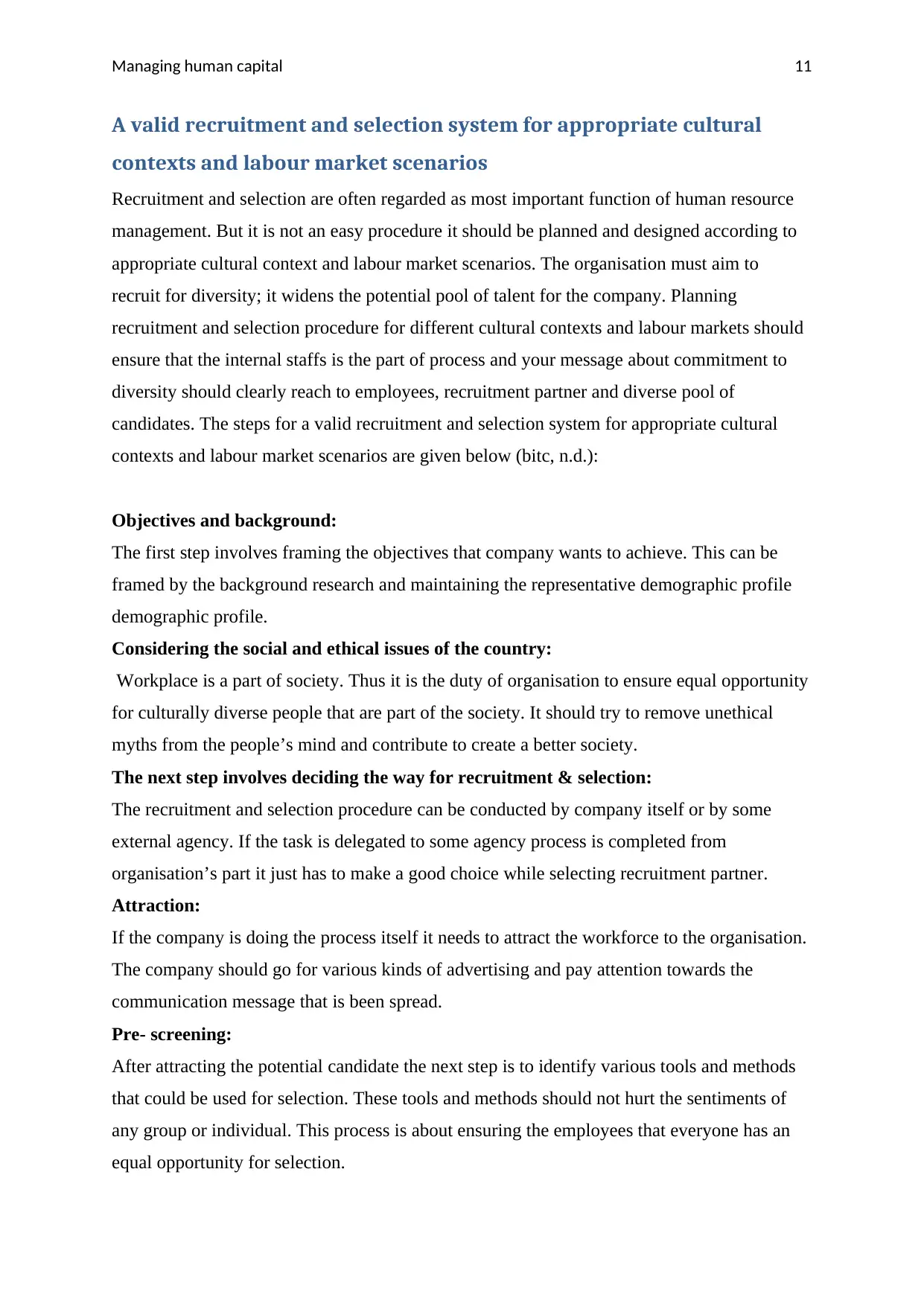
Managing human capital 11
A valid recruitment and selection system for appropriate cultural
contexts and labour market scenarios
Recruitment and selection are often regarded as most important function of human resource
management. But it is not an easy procedure it should be planned and designed according to
appropriate cultural context and labour market scenarios. The organisation must aim to
recruit for diversity; it widens the potential pool of talent for the company. Planning
recruitment and selection procedure for different cultural contexts and labour markets should
ensure that the internal staffs is the part of process and your message about commitment to
diversity should clearly reach to employees, recruitment partner and diverse pool of
candidates. The steps for a valid recruitment and selection system for appropriate cultural
contexts and labour market scenarios are given below (bitc, n.d.):
Objectives and background:
The first step involves framing the objectives that company wants to achieve. This can be
framed by the background research and maintaining the representative demographic profile
demographic profile.
Considering the social and ethical issues of the country:
Workplace is a part of society. Thus it is the duty of organisation to ensure equal opportunity
for culturally diverse people that are part of the society. It should try to remove unethical
myths from the people’s mind and contribute to create a better society.
The next step involves deciding the way for recruitment & selection:
The recruitment and selection procedure can be conducted by company itself or by some
external agency. If the task is delegated to some agency process is completed from
organisation’s part it just has to make a good choice while selecting recruitment partner.
Attraction:
If the company is doing the process itself it needs to attract the workforce to the organisation.
The company should go for various kinds of advertising and pay attention towards the
communication message that is been spread.
Pre- screening:
After attracting the potential candidate the next step is to identify various tools and methods
that could be used for selection. These tools and methods should not hurt the sentiments of
any group or individual. This process is about ensuring the employees that everyone has an
equal opportunity for selection.
A valid recruitment and selection system for appropriate cultural
contexts and labour market scenarios
Recruitment and selection are often regarded as most important function of human resource
management. But it is not an easy procedure it should be planned and designed according to
appropriate cultural context and labour market scenarios. The organisation must aim to
recruit for diversity; it widens the potential pool of talent for the company. Planning
recruitment and selection procedure for different cultural contexts and labour markets should
ensure that the internal staffs is the part of process and your message about commitment to
diversity should clearly reach to employees, recruitment partner and diverse pool of
candidates. The steps for a valid recruitment and selection system for appropriate cultural
contexts and labour market scenarios are given below (bitc, n.d.):
Objectives and background:
The first step involves framing the objectives that company wants to achieve. This can be
framed by the background research and maintaining the representative demographic profile
demographic profile.
Considering the social and ethical issues of the country:
Workplace is a part of society. Thus it is the duty of organisation to ensure equal opportunity
for culturally diverse people that are part of the society. It should try to remove unethical
myths from the people’s mind and contribute to create a better society.
The next step involves deciding the way for recruitment & selection:
The recruitment and selection procedure can be conducted by company itself or by some
external agency. If the task is delegated to some agency process is completed from
organisation’s part it just has to make a good choice while selecting recruitment partner.
Attraction:
If the company is doing the process itself it needs to attract the workforce to the organisation.
The company should go for various kinds of advertising and pay attention towards the
communication message that is been spread.
Pre- screening:
After attracting the potential candidate the next step is to identify various tools and methods
that could be used for selection. These tools and methods should not hurt the sentiments of
any group or individual. This process is about ensuring the employees that everyone has an
equal opportunity for selection.
⊘ This is a preview!⊘
Do you want full access?
Subscribe today to unlock all pages.

Trusted by 1+ million students worldwide
1 out of 18
Related Documents
Your All-in-One AI-Powered Toolkit for Academic Success.
+13062052269
info@desklib.com
Available 24*7 on WhatsApp / Email
![[object Object]](/_next/static/media/star-bottom.7253800d.svg)
Unlock your academic potential
Copyright © 2020–2025 A2Z Services. All Rights Reserved. Developed and managed by ZUCOL.




